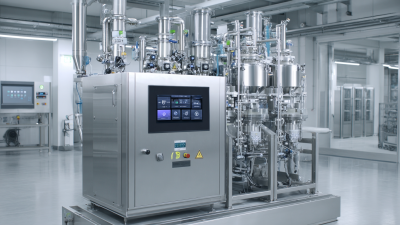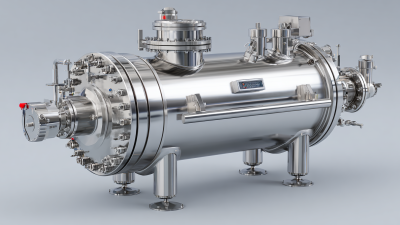These days in biological research, everyone pretty much agrees that Cell Homogenizers are absolute must-haves when it comes to prepping cellular samples. Honestly, they’re game-changers—they help break down cell walls so scientists can grab hold of those precious biological compounds that are often key to all sorts of analyses. I came across a market report by Research and Markets, and it’s crazy—by 2025, the global market for these devices is projected to hit around $3.75 billion! That just shows how much demand there’s been, especially in pharma, biotech, and environmental testing circles. There’s a company called CAS PETER (HANGZHOU) NANOTECHNOLOGY CO., LTD that’s really making waves here. They're all about pushing the boundaries with nanotech and specialize in high-pressure homogenizers and microfluidizers—stuff that’s perfect for a wide range of industry needs. As molecular biology keeps evolving, having reliable and efficient cell homogenization tools isn’t just a nice-to-have anymore; it’s essential. Companies like CAS PETER are the ones really driving research forward and helping scientists make those breakthrough discoveries.

Cell homogenizers are pretty essential tools in today's biological research, especially when it comes to preparing samples. They help break down cells efficiently, making it much easier for scientists to extract proteins, DNA, RNA, and other important biomolecules. Honestly, this step is crucial for a bunch of things like developing new drugs, studying genetics, and analyzing how metabolic processes work.
At CAS PETER (HANGZHOU) NANOTECHNOLOGY CO., LTD, we focus on high-pressure homogenizers and microfluidizers that are designed to meet the needs of modern labs. Our state-of-the-art technology ensures your samples are processed consistently, which helps make your experiments more reliable and reproducible. We’re all about providing innovative nanotech solutions that fit both academic labs and industrial research—you know, staying ahead of the game.
When you're choosing a homogenizer, keep in mind things like the type of sample you're working with, what particle size you're aiming for, and how much you need to process. Picking the right one for your specific application will definitely give you more accurate and trustworthy results. And don’t forget—regular maintenance of your equipment is super important for keeping it running smoothly and lasting longer. In the end, a good homogenizer can really be a game-changer in your lab.

Using cell homogenizers is pretty much a must in today's biological research—everyone knows how important it is to get consistent, reliable results. Basically, homogenizers help break down cell structures so you can efficiently extract proteins, nucleic acids, and other biomolecules. I came across a recent study in the Journal of Biological Engineering that really stressed this: when samples are evenly broken down, it minimizes experimental variability. They reported that with proper use of homogenizers, the variation in protein measurements drops below 5%, which is pretty impressive.
Now, if you're using a cell homogenizer, there are a few tips and tricks to make sure everything runs smoothly. First off, it's all about choosing the right method for your sample—tough tissues usually need mechanical homogenization, while softer ones might do better with enzymatic approaches. Also, paying attention to details like temperature and how long you homogenize can really make a difference in the quality of your extract. Plus, these practices aren’t just for biology—there’s a cool crossover with material science too, like in the design of lattice metamaterials where multiscale homogenization techniques are used to balance micro- and macroscale properties for stability and performance. Pretty fascinating how these fields overlap, right?

Picking the right type of cell homogenizer really matters when you're trying to get good samples and reliable results in your biological experiments. There’s a bunch of different techniques and machines out there, each suited for specific jobs. For example, mechanical homogenizers like bead mills and rotor-stator setups are great if you’re dealing with tough cell membranes or need high shear forces to break cells apart. They’re pretty efficient at disrupting cells but still gentle enough to keep sensitive biomolecules intact—perfect for things like proteomics or metabolomics studies.
On the flip side, if you’re working with delicate cells or need to avoid heat buildup, softer approaches like French press or ultrasonic homogenizers might be better. Picking the right tool really depends on how fragile your samples are and what you plan to do next. If you’re working with delicate cells like primary neurons or stem cells, you want a method that applies just enough shear without overheating or damaging them. Basically, understanding what your research needs will help you choose the best homogenizer, leading to better quality results and more reproducible experiments.
In today's biological research, homogenization is such a vital step when prepping samples. It’s what helps scientists get a uniform mixture, which is super important for getting accurate results. During this process, you really want to keep an eye on things like pressure, temperature, and how long you’re homogenizing. Recent studies actually show that even small changes in pressure can really impact particle size distribution — and that’s a big deal, whether you’re working on drug development or food science. For example, pushing pressure above 2000 bar can shrink particles down to nanoparticles, which boosts how well drugs get absorbed in the body.
Here at CAS PETER (HANGZHOU) NANOTECHNOLOGY CO., LTD, we’re experts in high-pressure homogenizers and microfluidizers, so we know how to help researchers dial in those parameters precisely. With our cutting-edge nanotech equipment, you can count on consistent, reliable results—whether you’re doing lab work or pushing forward with industrial projects.
Quick tip: Keep an eye on the temperature during homogenization. Too much heat can mess with sensitive biological samples. Also, it helps to run some trial tests first to figure out the perfect pressure for your specific sample—that way, you can get the best results without risking sample damage.
Cell homogenization is really a cornerstone in modern biological research, especially when you're trying to extract key biomolecules like RNA and proteins from different tissues. I mean, it’s pretty important, but let’s be honest — it can be tricky. Researchers often struggle with getting consistent cell counts and making sure the samples don’t break down during the process. One cool new approach that’s gaining popularity is using automated homogenization, which helps cut down on manual work. This way, you’re less likely to get variability, which is a big deal when preparing biopharmaceuticals. Recent studies actually show that these automated methods make homogenization more reliable — especially when it comes to aliquoting in pharma, helping us achieve uniform cell concentrations that really matter for accurate results.
A quick tip: when you’re homogenizing tissues, don’t forget to use the right buffers, like RLT lysis buffer, to keep RNA intact. And if you’re dealing with tougher samples, like human skin biopsies or microalgae, technologies like sonication or ultrasound-assisted extraction can totally boost your protein yield.
Plus, with the latest advances in lipid nanoparticle tech, it’s clear that consistency in homogenization is key. Not only does it help avoid unwanted immune responses, but it also ensures safety and effectiveness in drug formulations. These innovations really show how tackling homogenization challenges is crucial, whether you're doing research or developing new therapies. Overall, it’s all about making processes more reliable so we can push forward with better treatments and scientific discoveries.
Lately, there's been a lot of exciting progress in cell homogenization tech, and it’s really changing the game in biological research. Modern homogenizers are now packed with cool features like adjustable shear rates, temperature control, and different rotor-stator setups. These upgrades give scientists more control, helping them optimize the cell lysis process so they get more biomolecules and better-quality extracts. For example, using both mechanical and non-mechanical methods, researchers can carefully break down cell walls without damaging sensitive inside components — which is super important for whatever tests come next.
Plus, the jump to automation and smart tech in these machines makes everything more consistent and efficient. Automated systems cut down on human error, so you get reliable results every time. That’s a big deal when you’re doing high-throughput screenings or large-scale bioproduction, where even tiny variations can throw things off. Being able to process samples quickly not only speeds things up but also opens doors to more complex experiments. All of this pushes our understanding of how cells work—and how diseases develop—even further.
: The homogenization process is crucial for preparing samples to achieve a uniform mixture, which is essential for accurate analysis in biological research.
The key parameters include pressure, temperature, and homogenization time.
Variations in pressure can significantly affect particle size distribution, with levels exceeding 2000 bar capable of reducing particle sizes to nanoparticles, which can enhance bioavailability in pharmaceutical applications.
CAS PETER provides high-pressure homogenizers and microfluidizers that allow researchers to precisely control key parameters during the homogenization process.
Employing automated homogenization techniques can minimize variability, while using appropriate buffers can maintain RNA integrity and enhance protein yield.
Excessive heat can denature sensitive biological materials, so it is important to regularly monitor temperature during the homogenization process.
Techniques such as sonication and ultrasound-assisted extraction can significantly enhance protein yield from challenging matrices.
Advancements in lipid nanoparticle development emphasize the need for consistent homogenization techniques to ensure safety and efficacy in drug formulations.
Researchers should conduct preliminary tests to determine the optimal pressure for their specific sample type, enhancing efficiency while maintaining sample integrity.
Common challenges include achieving consistent cell counts and avoiding sample degradation during the homogenization process.
Cell homogenizers are really essential in modern biological research because they help prepare samples effectively. When used right, they make sure that cellular components are evenly mixed, which is super important for getting accurate results. Following best practices with these devices can really make a difference, helping to keep experiments consistent and reproducible. Choosing the right type of homogenizer matters a lot, since different tasks might need specific features to get the best outcome.
Keeping an eye on key settings like pressure and timing during the process can save you a lot of headaches and help you avoid common issues in sample prep. Plus, recent tech advancements—think high-pressure homogenizers and microfluidizers—are really opening up new possibilities in research across many fields. At CAS PETER (HANGZHOU) NANOTECHNOLOGY CO., LTD, we’re all about offering the latest nanotech solutions to support the diverse needs of modern biology and industry applications.







